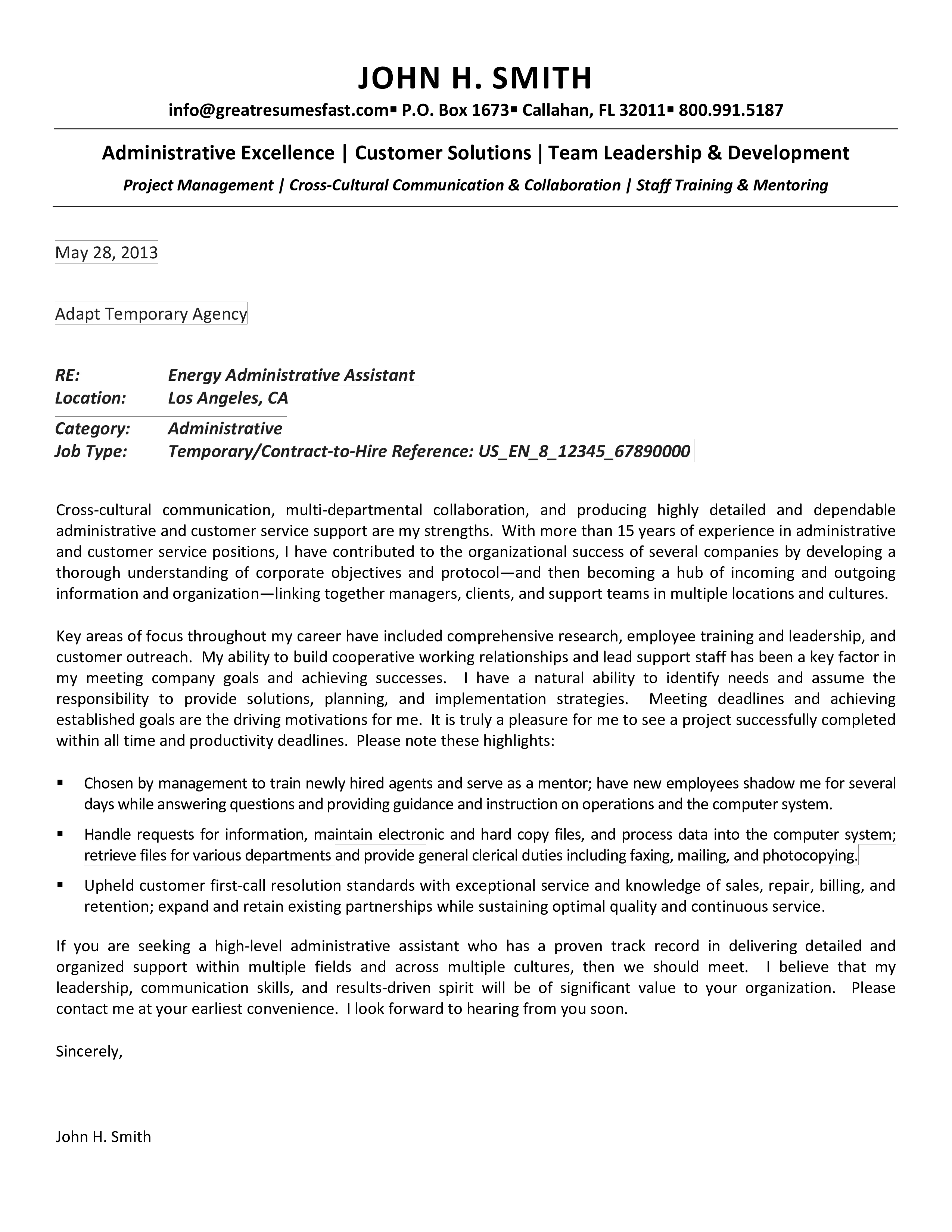What is an Administrative Assistant Cover Letter?
An administrative assistant cover letter is a crucial document that accompanies your resume when applying for administrative assistant positions. It serves as your introduction to the hiring manager and provides an opportunity to showcase your personality, skills, and qualifications in a more personalized way than your resume allows. It is your first chance to make a strong impression and convince the employer that you are the ideal candidate for the job. The purpose of the cover letter is to highlight why you are the best fit for the role, aligning your skills and experience with the job requirements and demonstrating your interest in the specific company. A well-crafted cover letter can significantly increase your chances of getting an interview.
Why is a Cover Letter Important?
Cover letters are important because they offer a space for you to expand on the information provided in your resume. While a resume offers a concise overview of your work history and skills, a cover letter allows you to elaborate on specific experiences, explain your motivations, and demonstrate how your qualifications align with the job requirements. It is a way to show your personality and enthusiasm for the role. A cover letter can also help you stand out from other applicants. In a competitive job market, a well-written cover letter can set you apart from candidates who only submit resumes. It gives you the chance to showcase your writing skills, attention to detail, and understanding of the company’s needs.
Essential Components of a Cover Letter
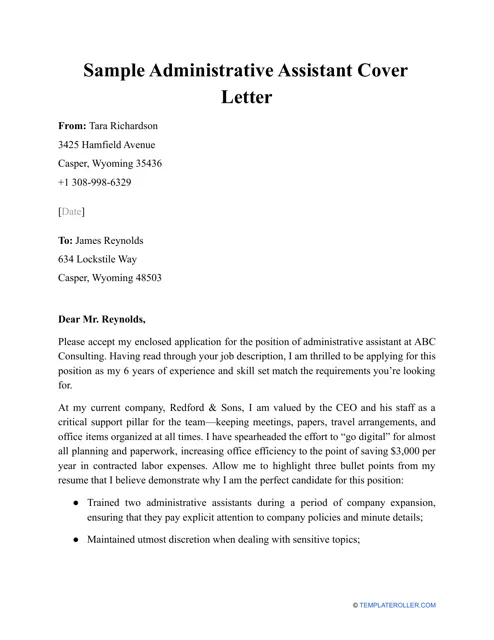
Every administrative assistant cover letter should include the standard components. Following these guidelines is important to get the attention of the hiring manager. These components work together to create a professional and compelling document that effectively communicates your qualifications and enthusiasm for the role. Properly including all the essential elements will make your cover letter stand out.
Your Contact Information
At the top of your cover letter, provide your contact information, including your full name, phone number, email address, and optionally, your LinkedIn profile URL. This information ensures the hiring manager can easily reach you to schedule an interview or request further information.
The Date
Include the current date below your contact information. This helps the hiring manager know when the cover letter was written.
Hiring Manager’s Contact Information
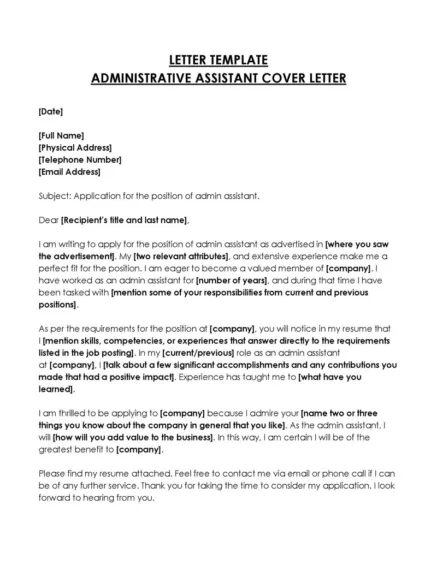
If possible, address your cover letter to a specific person (the hiring manager). Research the company to find the hiring manager’s name and title. Addressing the letter to a specific person shows that you have taken the time to learn about the company and the role. If you are unable to find the hiring manager’s name, use a professional salutation like “Dear Hiring Manager.”
Salutation
Start your cover letter with a professional salutation. Use “Dear [Hiring Manager’s Name],” or if you don’t know the name, use “Dear Hiring Manager.”
Body Paragraph 1 What is the purpose of cover letter?
The first paragraph of your cover letter should state the position you are applying for and where you found the job posting. Briefly mention why you are interested in the role and the company. Express your enthusiasm for the opportunity. Your opening paragraph should be engaging and capture the reader’s attention. It sets the tone for the rest of the letter and shows the hiring manager why you are interested in the role.
Body Paragraph 2 Highlight Your Skills and Experience
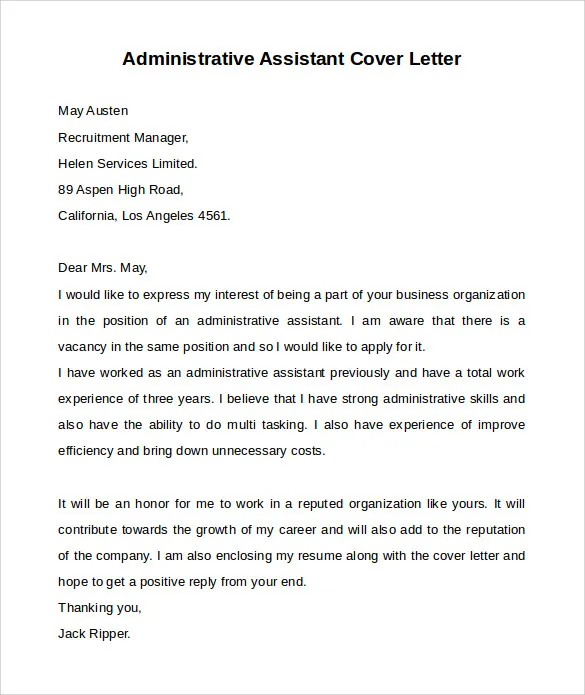
In the second paragraph, highlight your relevant skills and experience. Provide specific examples of how you have used these skills in previous roles and achieved positive outcomes. Focus on the key requirements outlined in the job description and how your experience aligns with them. Quantify your achievements whenever possible by using numbers to show the impact of your work. This section is crucial for demonstrating your capabilities and convincing the hiring manager that you possess the necessary qualifications. Mention any relevant experience that would be beneficial for the specific company.
Key Administrative Skills
Administrative assistants need a combination of skills, and it is important to highlight the essential skills that make a great admin assistant. Some of the key skills include proficiency in Microsoft Office Suite, excellent communication skills, organizational and time management skills, and a strong attention to detail. When explaining these skills, you should give detailed examples that highlight your accomplishments. For example, if you improved a filing system, make sure you say how you improved it, and if possible, include the positive results of your work.
Proficiency in Microsoft Office Suite
Show your understanding and proficiency in Microsoft Office Suite applications, such as Word, Excel, PowerPoint, and Outlook. Mention any certifications or training you have. Describe how you have used these tools to create documents, manage spreadsheets, create presentations, and handle email correspondence. Demonstrate your ability to use these tools effectively and efficiently.
Excellent Communication Skills
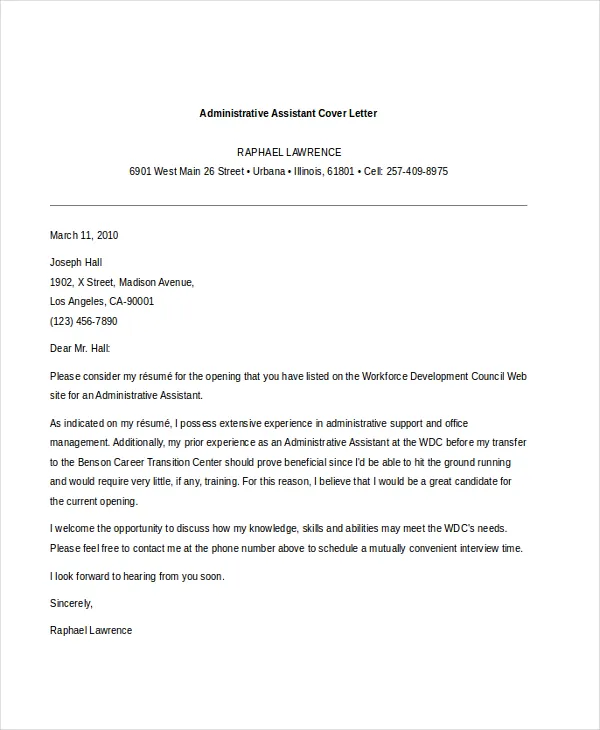
Emphasize your excellent written and verbal communication skills. Provide examples of how you have effectively communicated with colleagues, clients, and supervisors. Highlight your ability to write clear and concise emails, compose professional correspondence, and communicate complex information in a way that is easy to understand. Demonstrate your active listening skills, and ability to provide top-notch customer service.
Organizational and Time Management Skills
Showcase your organizational and time management skills. Detail how you have managed multiple tasks simultaneously, prioritized tasks, and met deadlines. Provide specific examples of how you have used these skills to improve efficiency, reduce errors, or increase productivity. Show your ability to manage schedules, coordinate meetings, and handle various administrative tasks efficiently.
Attention to Detail
Highlight your strong attention to detail. Administrative assistants need to be detail-oriented to ensure accuracy in all aspects of their work. Provide examples of how you have maintained accuracy in your work, such as proofreading documents, verifying data, and following procedures. Demonstrate your ability to catch errors, identify inconsistencies, and maintain a high level of accuracy in your work.
Body Paragraph 3 Tailor Your Cover Letter to the Job
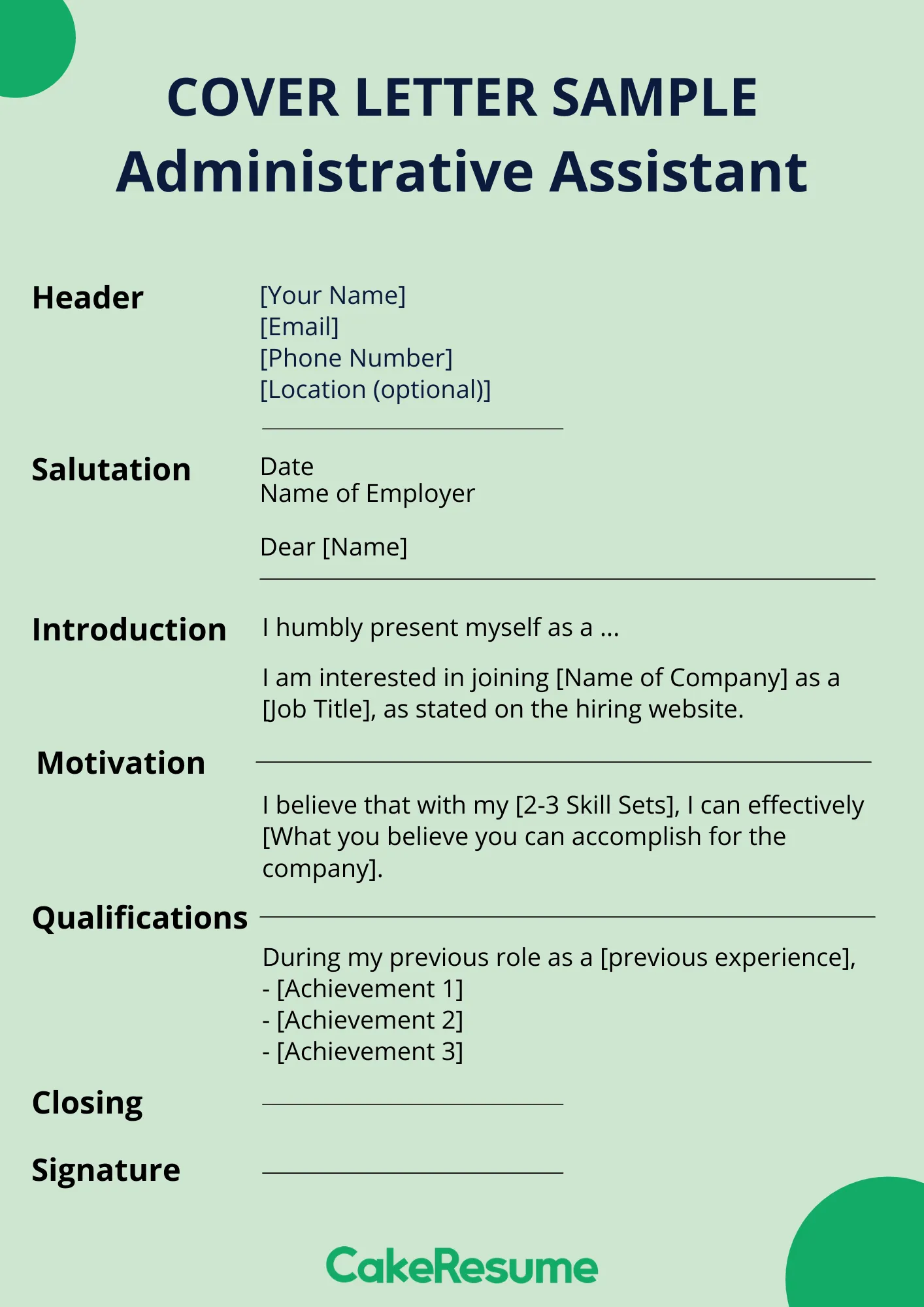
This is the paragraph where you tie your skills and experience to the specific requirements of the job. Customize your cover letter to show the hiring manager that you understand the company’s needs. Demonstrate your understanding of the company’s mission, values, and culture. Show how your skills and experience align with the company’s goals and objectives. By showing you have done your homework and understand their needs, you increase the chances of getting the job.
Research the Company
Before writing your cover letter, research the company. Visit their website, read their mission statement, and learn about their products or services. Understand their values and culture. This information will help you tailor your cover letter to highlight your relevant experience and explain how your skills align with the company’s needs. Understanding the company’s mission and values will also help you answer questions about why you want to work at their company.
Use Keywords from the Job Description
Carefully review the job description and identify the keywords that describe the required skills and qualifications. Integrate these keywords naturally into your cover letter to demonstrate that you meet the job requirements. This is very important as many companies use applicant tracking systems (ATS) to screen applications. Using the right keywords can help your application get past the initial screening.
Quantify Your Achievements
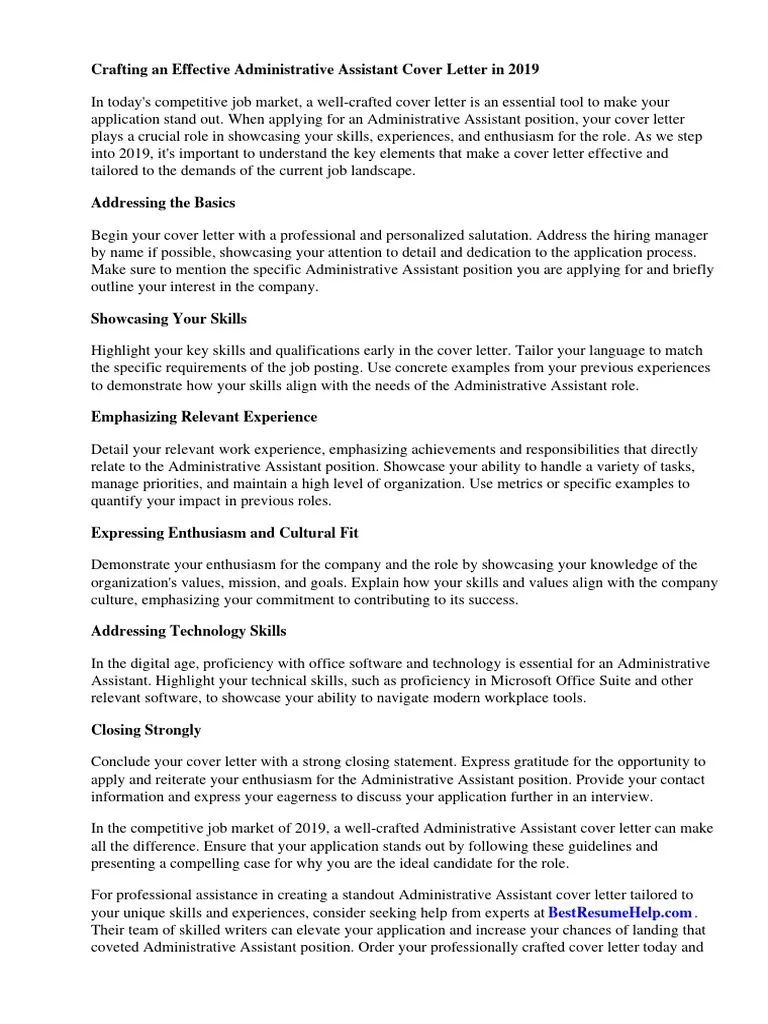
When describing your achievements, use numbers and metrics to demonstrate the impact of your work. For example, instead of saying “improved efficiency,” say “improved efficiency by 15%.” Quantifying your achievements gives the hiring manager a clear picture of your capabilities and the value you can bring to the role. This will make you stand out and increase your chances of getting hired.
Body Paragraph 4 Closing the Cover Letter
In your closing paragraph, express your enthusiasm for the opportunity and reiterate your interest in the role. Thank the hiring manager for their time and consideration. Include a call to action, such as stating that you look forward to hearing from them or inviting them to contact you for an interview. Make sure you maintain a professional and confident tone throughout the closing paragraph.
Express Your Enthusiasm
In your closing paragraph, show your genuine enthusiasm for the role and the company. State your excitement for the opportunity to contribute to their team. Make it clear that you are genuinely interested in the position and the company.
Call to Action
Include a call to action. Encourage the hiring manager to contact you for an interview or to discuss your qualifications further. This can be as simple as saying, “I look forward to hearing from you.” or “Thank you for considering my application. I am available for an interview at your earliest convenience.”
Proofread and Edit Your Cover Letter
Before submitting your cover letter, carefully proofread and edit it to ensure it is free of errors. Check for grammar, spelling, and punctuation mistakes. Use a spell checker and grammar checker, but also read the letter carefully yourself. Ask a friend or family member to review your cover letter for any errors or areas that could be improved. A polished and error-free cover letter demonstrates your attention to detail and professionalism.
Formatting Your Cover Letter
Format your cover letter professionally. Use a clear and readable font. Maintain consistent spacing and margins throughout the document. Keep your cover letter concise and easy to read, typically within one page. Proper formatting makes your cover letter look professional and easy to read. Ensure a clean and organized layout will make your application stand out. It should look clean and professional.
Choosing the Right Font
Select a professional and readable font, such as Times New Roman, Arial, or Calibri. Use a font size between 10 and 12 points. Avoid using overly fancy or decorative fonts. Make sure your chosen font is easy to read and looks professional.
Maintaining a Professional Tone
Write your cover letter in a professional tone. Use formal language and avoid slang or contractions. Maintain a positive and enthusiastic tone throughout the letter. Your cover letter should convey professionalism and respect.
Common Mistakes to Avoid
Avoid making common mistakes to increase your chances of getting hired. These include ignoring the job description, using generic language, and making typos or grammatical errors. To avoid these mistakes, make sure you tailor your cover letter to the specific job requirements. Proofread it carefully before sending it to the hiring manager.
Ignoring the Job Description
Do not submit a generic cover letter. Make sure you tailor it to the specific job description. Highlight the skills and experiences that align with the job requirements. Address the specific needs of the company. Make sure the cover letter meets the needs of the job description to get a higher chance of getting hired.
Using Generic Language
Avoid using generic language. Do not use overly general statements. Provide specific examples of your skills and achievements. Use keywords from the job description. Avoid using phrases that could apply to any job. Make sure your cover letter is specific to the role you are applying for.
Typos and Grammatical Errors
Typos and grammatical errors can damage your credibility. Always proofread your cover letter before submitting it. Use a spell checker and grammar checker. Have someone else review your cover letter for errors. Make sure the cover letter is free of errors to make a good impression.
Submitting Your Cover Letter
Follow the instructions in the job posting for submitting your cover letter. In most cases, you will submit your cover letter as an attachment to your online application or via email. Make sure you save your cover letter as a PDF file to maintain the formatting. Make sure you submit your cover letter correctly to make a good impression. Following all of the instructions will make your cover letter stand out.
How to Submit Your Cover Letter
When submitting your cover letter, follow the instructions provided in the job posting. If the job posting requires you to submit your cover letter online, attach it as a PDF file. If you are submitting your cover letter via email, include your name and the job title in the subject line. Always make sure you send your cover letter in the requested format. Make sure you are following all of the instructions for submitting the cover letter.
Next Steps after Submission
After submitting your cover letter, follow up with the hiring manager. Send a thank-you email to the hiring manager within a day or two of submitting your application. In the email, reiterate your interest in the role and thank them for their time. If you have not heard back within the timeframe specified in the job posting, follow up with a polite email or phone call. Make sure you take the appropriate steps to make sure you get the job.
